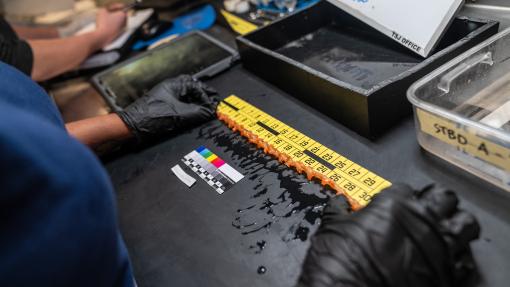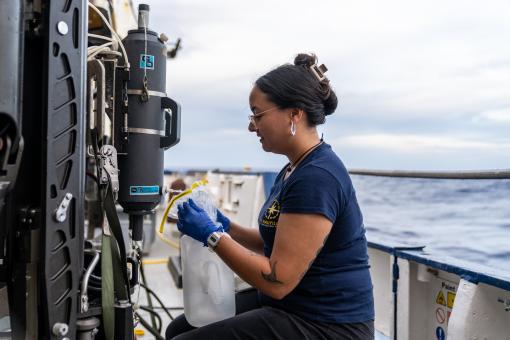From the seafloor to the lab: sampling techniques for deep sea science
Nautilus explores some of the most remote and least understood regions of the deep sea, collecting vital exploration data in areas that have rarely, if ever, been visited by humans. This data fuels further exploration and scientific discovery, enriching our understanding of the complex ecosystems that lie beneath the surface. Integral to this mission is the careful collection of a limited number of physical samples, which serve as essential records of the environmental conditions and species encountered during each expedition.

The Role of Sampling in Deep-Sea Research
Sampling aboard the Nautilus is a thoughtful and methodical process, conducted with the utmost respect for the deep-sea ecosystems we explore. A dedicated team of scientists onboard and participating from shore decides when and where to collect biological, geological, and water samples to deepen our understanding of these rarely seen environments and contribute to scientific discoveries.
Each sample is carefully gathered using a variety of precision tools on ROV Hercules, ensuring minimal impact on the species and habitats we encounter. After being brought to the surface, each specimen is documented, processed, and preserved for future scientific studies, creating valuable insights into the unique organisms and geological features of the deep sea. By studying these specimens, scientists around the world can characterize biodiversity, examine the geological context, and investigate environmental DNA (eDNA) to uncover previously unknown aspects of the deep sea. This intentional approach to sampling allows us to advance scientific knowledge while maintaining our commitment to environmental stewardship.
Read on to explore the sampling tools we use and the processing steps taken onboard.

Tools of the Trade for Sampling the Deep Sea
ROV Hercules is equipped with a suite of instruments to support scientific data and sample collections. A wide variety of samples are collected, requiring different methods depending on the size and fragility of the sample.
Grab
The most basic method is a “grab” with the manipulator arms located on ROV Hercules, which have two-fingered jaws on the end used for gripping. The jaws may be oriented parallel or intermeshing, offset from each other, depending on the vehicle configuration pre-dive. The jaws also include scissor-like cutters that help take small snips of large organisms, like clipping off a small portion of a branch of deep-sea coral.
Slurp
For small, delicate, or flexible specimens, the “slurp” hose is used to ensure that the sample is collected carefully and safely. ROV pilots pick up the handle of this vacuum-like hose with the manipulator arm, which then slurps up water, sediment, and small or delicate fauna and funnels it into a plexiglass container. There are eight rotating slurp chambers on Hercules, one of which is used in reserve to flush out the hose between samples. Fine or coarse mesh can be placed at the chamber exits, preventing smaller organisms or fine-grained particles from escaping. The suction on the slurp pump is variable, allowing the hose to be used to gently “grab” delicate organisms -like sea cucumbers or sea urchins- and gently place them into a biobox.
Sediment Cores
For sediment sampling, the most frequently used technique is the push core. A push core is a clear tube with a handle for the manipulator arm to hold. As its name suggests, the core is pushed down into the sediment and then carefully pulled back out, complete with sediment. This method allows the horizontal layers of sediment and infauna to be preserved, for further analysis, including for composition. The core is then pushed into a holder or “quiver” with a rubber stopper on the bottom to contain the sediment until the ROV is recovered to the surface. Alternatively, we can use a scoop to collect sediment where layering is not important or use the slurp hose when collecting rubble.
Water Samples
Water samples are mostly collected using "Niskin" bottles, grey cylinders attached to the port (or left) side of Hercules. Each Niskin bottle can capture 5 liters (about 1.3 gallons) of water. The ROV’s manipulator arm triggers the end caps of the bottle to close, trapping the water inside. Once sealed, the sample stays safe and isolated from the surrounding seawater until the ROV returns to the surface. One bottle is often used to collect background data from a low-macrofauna seafloor area, like bare sediment. The other bottles can be used to sample water near interesting features, such as deep-sea corals, sponges, or vents. These water samples are often used for environmental DNA (eDNA) studies or chemical analyses, helping scientists learn more about the environment in that area.
Other Sampling Methods
In addition to the standard sampling tools, scientists aboard Nautilus may bring their own specialized equipment to collect more specific measurements. This has included using custom chemical sampling instruments to capture water or gas samples, often designed to maintain the pressure of the deep-sea environment. This ensures that the samples are preserved exactly as they were on the seafloor, allowing for more accurate chemical analysis. These specialized tools can also be used to measure pollutants or contaminants in the deep sea, providing valuable data on the health of these remote ecosystems.
Science at Sea: Processing and Preserving Deep-Sea Samples
As soon as ROV Hercules returns to Nautilus for recovery, the wet lab becomes a flurry of activity as the onboard science team springs into action to quickly and carefully sort, process, and archive each of the special samples collected from the seafloor.
Each sample is removed from the bioboxes, placed into labeled bins, and transferred to the wet lab. The onboard science teams make detailed observations of each specimen, describing key characteristics and colors, taking measurements, and collecting high-quality images.
Biological specimens are then preserved in ethanol for future DNA analysis, while larger specimens (like corals) may be dried to maintain their structure. All biological samples are shipped to the Harvard Museum of Comparative Zoology after each expedition.

Geological samples, including rocks and sediments, are similarly dried and stored in labeled bags. Push cores are either extruded for analysis in layers or shipped intact for later study. These samples are sent to a repository at the University of Rhode Island for further examination. These samples have been key to new studies about things like ocean health, climate change, and geohazards.
Water samples are taken to the lab and processed depending on the scientific goals of each expedition. Often, water samples are collected for environmental DNA (eDNA) analysis to identify species in an ecosystem, including those not visible in ROV footage. After emptying the Niskins and transferring the water to the lab, eDNA is captured by pumping water through a fine mesh filter, which collects DNA fragments shed by organisms. The filters are stored at -80°C until returning to port, when they are sent for further analysis to varying partner institutions.

Scientists
Participate live as we explore through our Scientist Ashore Program via telepresence, and request data and samples.
Expeditions
Get a sneak peek of where we're headed next or revisit the discoveries of our past expeditions.
Publications
Explore the list of manuscripts, books and book chapters, theses, and dissertations from the data and samples collected aboard Nautilus.
